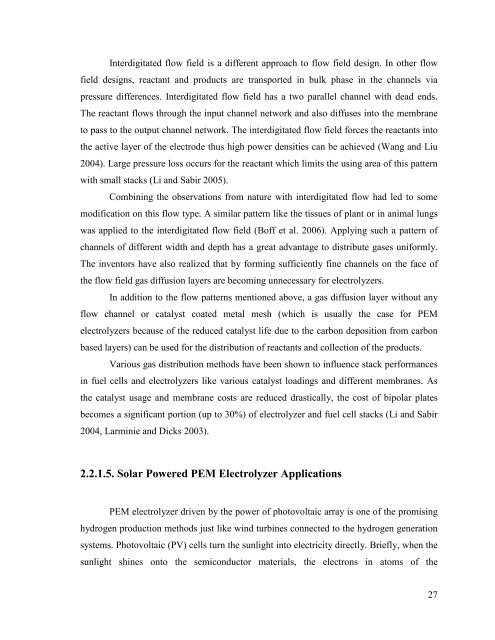hydrogen production from water using solar cells powered nafion ...
hydrogen production from water using solar cells powered nafion ...
hydrogen production from water using solar cells powered nafion ...
You also want an ePaper? Increase the reach of your titles
YUMPU automatically turns print PDFs into web optimized ePapers that Google loves.
Interdigitated flow field is a different approach to flow field design. In other flow<br />
field designs, reactant and products are transported in bulk phase in the channels via<br />
pressure differences. Interdigitated flow field has a two parallel channel with dead ends.<br />
The reactant flows through the input channel network and also diffuses into the membrane<br />
to pass to the output channel network. The interdigitated flow field forces the reactants into<br />
the active layer of the electrode thus high power densities can be achieved (Wang and Liu<br />
2004). Large pressure loss occurs for the reactant which limits the <strong>using</strong> area of this pattern<br />
with small stacks (Li and Sabir 2005).<br />
Combining the observations <strong>from</strong> nature with interdigitated flow had led to some<br />
modification on this flow type. A similar pattern like the tissues of plant or in animal lungs<br />
was applied to the interdigitated flow field (Boff et al. 2006). Applying such a pattern of<br />
channels of different width and depth has a great advantage to distribute gases uniformly.<br />
The inventors have also realized that by forming sufficiently fine channels on the face of<br />
the flow field gas diffusion layers are becoming unnecessary for electrolyzers.<br />
In addition to the flow patterns mentioned above, a gas diffusion layer without any<br />
flow channel or catalyst coated metal mesh (which is usually the case for PEM<br />
electrolyzers because of the reduced catalyst life due to the carbon deposition <strong>from</strong> carbon<br />
based layers) can be used for the distribution of reactants and collection of the products.<br />
Various gas distribution methods have been shown to influence stack performances<br />
in fuel <strong>cells</strong> and electrolyzers like various catalyst loadings and different membranes. As<br />
the catalyst usage and membrane costs are reduced drastically, the cost of bipolar plates<br />
becomes a significant portion (up to 30%) of electrolyzer and fuel cell stacks (Li and Sabir<br />
2004, Larminie and Dicks 2003).<br />
2.2.1.5. Solar Powered PEM Electrolyzer Applications<br />
PEM electrolyzer driven by the power of photovoltaic array is one of the promising<br />
<strong>hydrogen</strong> <strong>production</strong> methods just like wind turbines connected to the <strong>hydrogen</strong> generation<br />
systems. Photovoltaic (PV) <strong>cells</strong> turn the sunlight into electricity directly. Briefly, when the<br />
sunlight shines onto the semiconductor materials, the electrons in atoms of the<br />
27

















